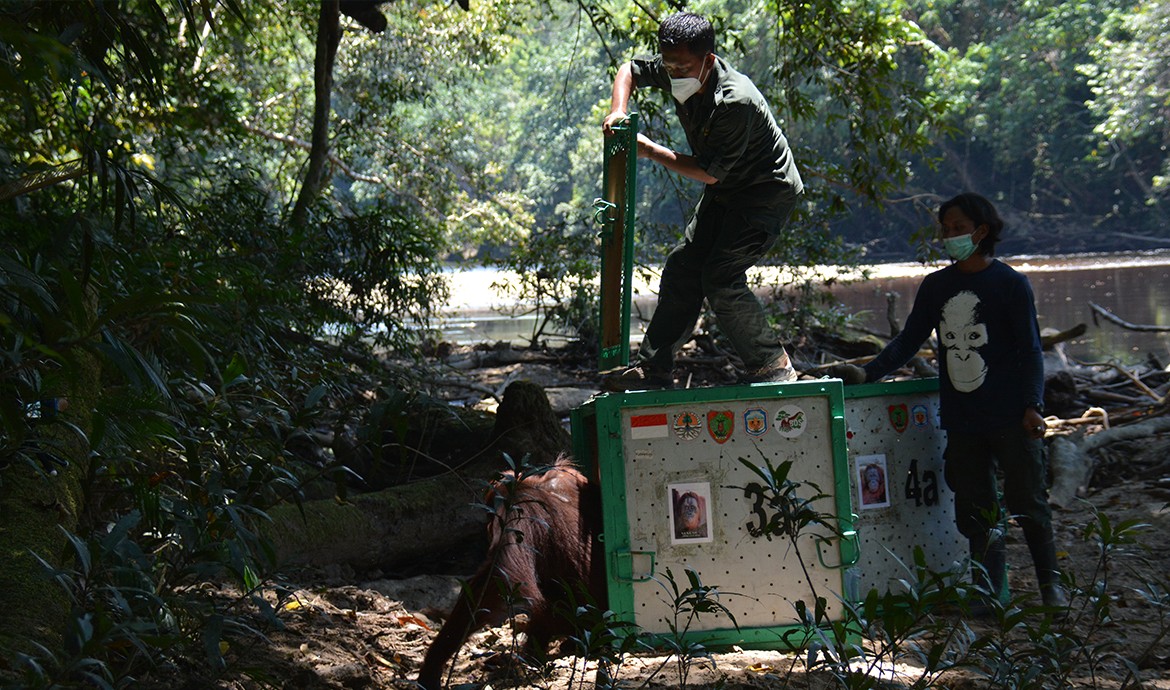In collaboration with the Central and East Kalimantan Natural Resources Conservation Agencies (BKSDA), the Borneo Orangutan Survival (BOS) Foundation has released 12 more orangutans from its two rehabilitation centres: Nyaru Menteng in Central Kalimantan and Samboja Lestari in East Kalimantan. The release in Central Kalimantan took place in the Bukit Batikap Protection Forest, while the release in East Kalimantan took place in the Kehje Sewen Ecosystem Restoration Concession.
The Central and East Kalimantan BKSDA and the BOS Foundation conducted these back-to-back orangutan releases utilising helicopter transport. The release in Central Kalimantan reintroduced eight rehabilitated orangutans from the Nyaru Menteng Orangutan Rehabilitation Centre into the Bukit Batikap Protection Forest in Murung Raya regency. Meanwhile, the release in East Kalimantan involved four orangutans from the Samboja Lestari Orangutan Rehabilitation Centre, who were released in the Kehje Sewen Forest in East Kutai and Kutai Kartanergara regencies.
The release in Central Kalimantan was conducted first, on 6 November, and involved five male and three female orangutans. From Nyaru Menteng, the eight orangutans were transported by car to the city of Kuala Kurun, in Gunung Mas regency, where a helicopter chartered from Heli SGI (PT. Sayap Garuda Indah) was standing by. They were then flown directly from Sangkalemu Airport to the release points in the heart of the Bukit Batikap Protection Forest.
“The Bukit Batikap Protection Forest in the Murung Raya Regency is located far from the Nyaru Menteng Orangutan Rehabilitation Centre; it usually takes a journey of three days and two nights to reach the camp by car and boat. Using helicopter transport, helps preserve animal welfare and saves a considerable amount of time.” Said SADTATA NOOR ADIRAHMANTA, S. Hut. M.T., Head of the Central Kalimantan Natural Resources Conservation Agency (BKSDA).
One of the orangutans released was Cici, a 19-year-old female orangutan. Cici initially underwent rehabilitation at the Samboja Lestari Rehabilitation Centre but was later transferred to the Nyaru Menteng Rehabilitation Centre. This transfer occurred after it was discovered that Cici belonged to the subspecies Pongo pygmaeus wurmbii, whose natural habitat is in Central Kalimantan and the southern parts of West Kalimantan. This relocation was important, as it would ensure that Cici could live in her natural habitat. Cici arrived at Nyaru Menteng in 2013 and, after ten years of rehabilitation, is now ready to be released into the wild. Her journey highlights the lengthy process and high costs involved in rehabilitating and releasing orangutans. The converse occurred in 2013, when three orangutans belonging to the Pongo pygmaeus morio subspecies who were rehabilitated in Central Kalimantan, we released into the Kehje Sewen Forest in East Kalimantan.
“When we release orangutans, we are not only releasing individuals, but also renewed hope for the future of the forest. Everything we have achieved here is clear evidence of the strong collaboration between the Central Kalimantan BKSDA and the East Kalimantan BKSDA in ensuring sustainability of the forest ecosystem. We hope that the orangutans we release will thrive and contribute to a healthy ecosystem. Successful releases help fuel our enthusiasm and replenish our energy to keep fighting for nature conservation in Indonesia.” Adirahmanta[AK1] added.
The release in East Kalimantan was conducted after the release in Central Kalimantan was complete. From the Samboja Lestari Orangutan Rehabilitation Centre, the release team travelled with one female and three male orangutans - aged between 13-30 years - to the pre-release island of Juq Kehje Swen, in Muara Wahau, East Kutai regency. From there, the same helicopter was waiting to transport them directly to the release point on the northern side of the Kehje Sewen Forest, which typically takes 2 days and 1 night of travel by car and boat from the Samboja Lestari Orangutan Rehabilitation Centre. This travel time is dependent on field conditions; roads are vulnerable to landslides, which can slow down the journey. Therefore, the choice to use a helicopter is important, as it cuts travel time and reduces the risk of using roads that are prone to dangerous landslides.
MATHEAS ARI WIBAWANTO, S.Hut., MSc., Head of the East Kalimantan Natural Resources Conservation Agency (BKSDA) welcomed the event; “The release of these four orangutans is a historic milestone in nature conservation. You see, we are not only releasing orangutans into their natural habitat, but also opening the door of hope for the survival of this species and the ecosystems they inhabit. Close collaboration between the East Kalimantan BKSDA and the BOS Foundation has produced positive steps that will be felt far into the future. Hopefully, our story will inspire many others to take part in preserving Indonesia's biodiversity.”
With this significant step forward, the Ministry of Environment and Forestry continues to make progress in the conservation and protection of its precious wildlife. Let’s keep working together to preserve our natural riches for a better future” He added.
DR. IR. JAMARTIN SIHITE, Msc., Chairman of the BOS Foundation said; “The commitment of the BOS Foundation in working with the government and other stakeholders to uphold the sustainability of orangutans and their habitats remains strong. The release of these twelve orangutans is proof of this close cooperation. We invite all parties to join hands to protect the forest, which is home to orangutans and rich in biodiversity. The steps we have planned and implemented are not only beneficial for the survival of orangutans, but also serve as a source of inspiration for others concerned about nature conservation. We at the BOS Foundation believe that together, hand-in-hand, we can create sustainable and positive changes for the future of planet Earth”.











